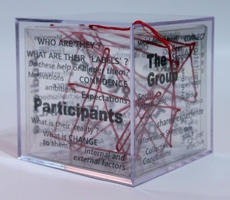View By Date Contact Me
7 Cubed
INTRODUCTION
 I began this assignment with the clear intention of simply assessing an older people’s group that I have been working with to achieve a user-led exhibition and a book. I wanted to view this work through a critical lens of specifically working with older people in a community arts based setting.
I began this assignment with the clear intention of simply assessing an older people’s group that I have been working with to achieve a user-led exhibition and a book. I wanted to view this work through a critical lens of specifically working with older people in a community arts based setting.
As I read more on working with older people and geragogy (the study of older people’ learning), I realised that there were real similarities and cross-over when working with anyone; regardless of their chronological age. Flexibility, adapting to change, the importance of social interactions for peer support and a sense of positive contribution are all life skills and desirable aims that any community arts group work should strive for. A more person-centred approach.
The Colour of the Work
As I was developing and researching these ideas I kept being drawn back to the principle idea of Gestalt psychology and counselling.
Gestalt, a german word that is difficult to directly translate; refers to pattern, shape, configuration or more precisely a person’s overall appearance; their totality (Mann, 2010:3). A deeper definition by Clarkson (2004) refers to the ‘structural entity’ that is both ‘different from and much more than the sum of its parts’:
The aim of the Gestalt approach is for a person to discover, explore and experience his or her own shape, pattern and wholeness. .the aim of Gestalt is the integration of all disparate parts. In this way people can let themselves become totally what they already are, and what they potentially can become. This fullness of experience can then be available to them both in the course of their life and in the experience of a single moment. (p.1)
When I was first introduced to this ‘big and small at the same time’ idea during my counselling training I immediately saw this idea in my mind as a visual process. The counselling session is a ‘blank canvas’ for a painting or collage and what the client brings is the content. Within gestalt the particular ‘story’ or narrative that the person brings is not important; the sketching out, details and embellishments. What is really the process is the overall picture, what I like to call the ‘colour in the work’; the hues, tones, lighting, mood and emotion of the painting.
This ‘bigger picture’ approach helped me to focus on what I thought was the important part of this project; the true colour of the work. I felt I needed to distil these ideas into common ground and how they work simultaneously. It was interesting how the title and premise of the exhibition ‘Greater Than the Sum’ kept evolving and returning in my own work throughout this project. Things were connecting.
Many Hats
As these ideas were forming in my mind about this idea of the whole, I was also thinking about my roles in this process. As with many art educators and practitioner’s roles we have to wear many hats, both in De Bono’s (1995) critical and reflective idea, but also practically, professionally and internally when approaching different individuals, organisations, work and groups.
All these different sides are separate, equal and need distinct methodologies, but are connected into a whole approach. These areas or facets of the work outlined here in this assignment and I will briefly go through each area.
The 7 Sided Cube
I am a great believer that inspiration can come from anywhere and in this case it came in the form of two sentences during Doctor Who (2012, 7x04):
Kate: Why do they all say seven?
The Doctor: Seven. Seven? What's important about seven? Seven Wonders of the World. Seven streams of the river Ota. Seven sides of a cube.
Amy: A cube has six sides.
The Doctor: Not if you count the inside.
- Doctor Who, "The Power of Three" (2012, Series 7, Episode 4)
Hearing this idea of a cube having a seventh side at that time just created a light bulb moment for me and brought everything together through the simplicity of the mechanics of the shape…
A person-centred approach to community arts work in the form of a cube.
All the six different facets of the work come together to create a whole. But also, more importantly, through coming together they form the final, and what I believe to be the most fundamental area – the Process itself; what the work and art is about. Through reflecting, considering and doing all these different sides to the work, the Process is happening. Work is happening - and with it the potential for change.
The Seven Sides
I began to develop this idea of seven sided work and began to refine and hone specific questions to ask myself, considerations and reminders about the different areas of work.
I used open questions and specific wording to open up the approach to work with an individual – or indeed any individual.
Using the Greater Than the Sum Exhibition and project as an exemplar to frame these questions and considerations around, I began forming different areas of approach.
And so, this approach is still evolving and I am still questioning what to include in each section. It has, however, already developed into a seven-sided tool to how I approach community arts. It includes questions, considerations and ways of perceiving the work to help me look at what areas or connections I need to develop or reflect on.
